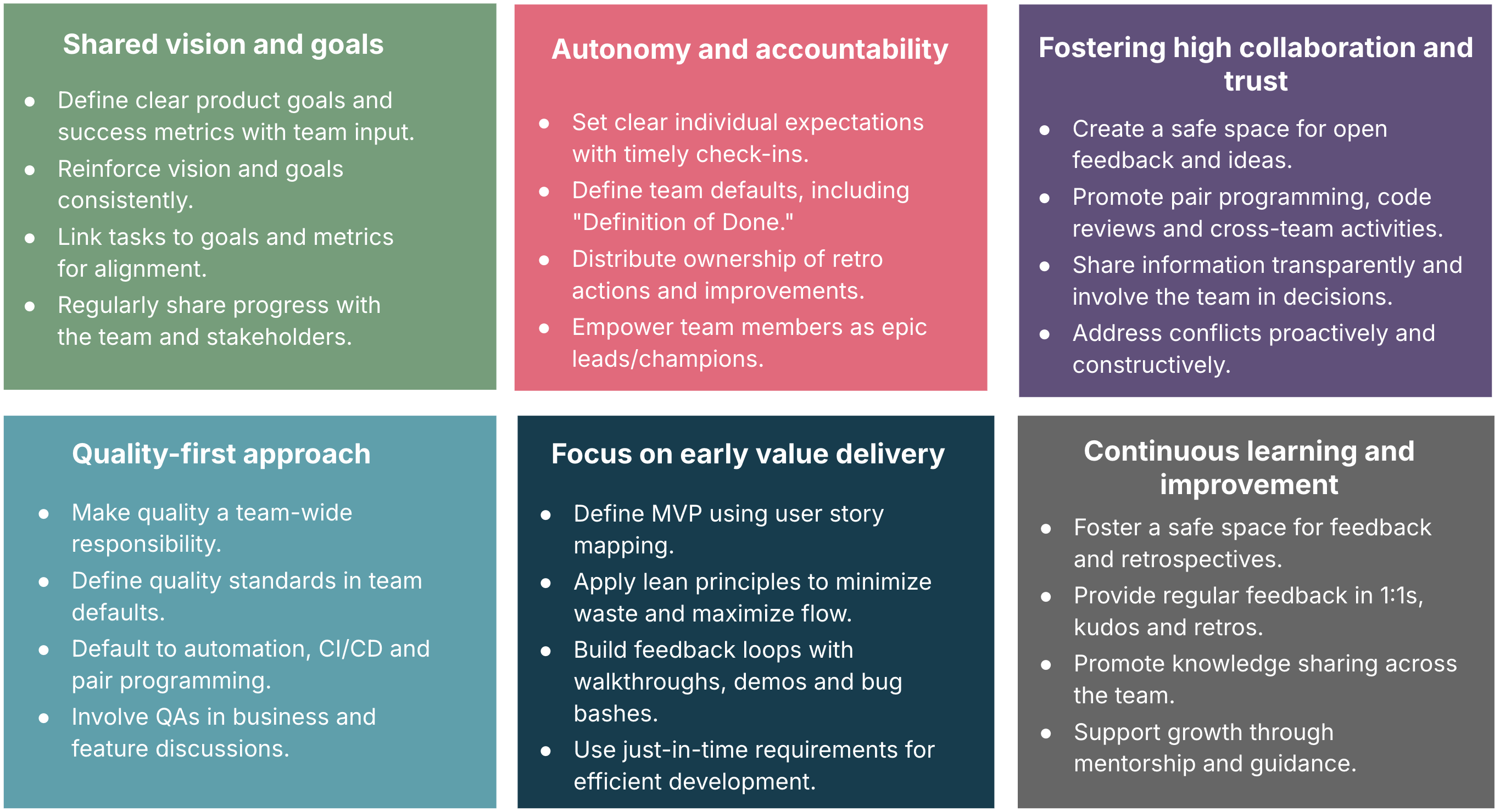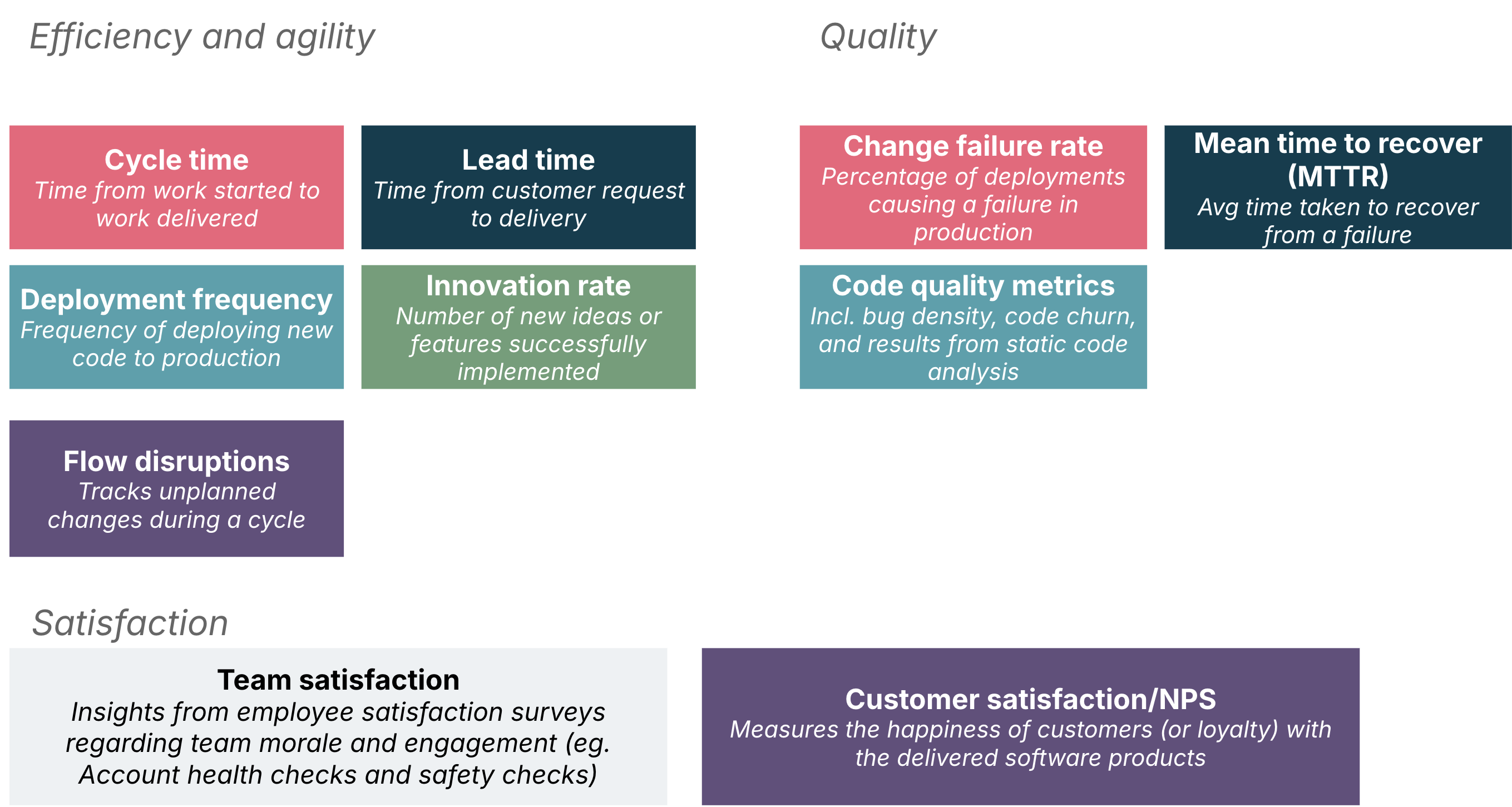Much has been written about high-performing teams, their foundational principles and the value they unlock for organizations. However, many leaders struggle to translate these principles into action and results. This blog post is an attempt to bridge the gap by connecting core principles with proven processes, systems and tactics that help build high-performing product development teams. It also outlines key metrics to assess progress and identify areas for improvement.
What are the foundations of high-performing teams?
High-performing teams are built on a number of important foundations. Let’s take a look at what these are and what they mean in practice.
Shared vision and goals
In his book Drive, Daniel H. Pink highlights "purpose" as a key driver of human motivation. Likewise, providing product teams with a shared vision and clear goals fosters alignment and accelerates value creation. High-performing teams don’t just work on tasks — they understand how their work contributes to broader business objectives.
To do this, it's essential to discover and articulate key business and product goals and metrics. This involves investing time upfront to identify key product goals using the relevant and available forums to communicate and embed them. Including the team in co-creation helps drive buy-in, build empathy for the user and foster collective problem-solving. (You can read more about this practice and our experiences here.)
Autonomy and accountability
A balance of autonomy and accountability enables teams to make faster, more effective decisions while staying aligned with organizational objectives. High-performing teams thrive when they have ownership over their work and clarity on outcome-oriented expectations.
But how can you actually enable autonomy and ensure accountability? Here are three things to keep in mind:
Establish clear expectations at an individual level. Hold structured 1:1 conversations to clarify individual expectations, growth paths and responsibilities, ensuring alignment with team outcomes and company goals.
Set clear expectations at a team level. Similarly, having clear ways of working and team sensible defaults ensures team members are able to make the right decisions upfront. That reduces the chances of mis-alignment and costly deviations.
Distribute and share ownership. Promote distributed ownership by encouraging team members to lead initiatives (modules, workstreams and features, for example.), own key deliverables and contribute to continuous improvement.
High collaboration and trust
Building high-quality solutions that customers love relies on smooth communication across the product team. Strong partnerships between design, development, QA and product management are key, because a lack of trust disrupts communication and hinders progress.
Building trust can be challenging, but there are a number of crucial tactics that can foster the kind of collaborative and trusting culture on which high performance is built:
Safe and open communication. Psychological safety can't be turned on instantly, but it can easily be undermined. Build a safe space for open communication in retrospectives and team cadences by removing authority figures (perhaps yourself) and addressing feedback with a growth mindset. Encourage participation, especially from introverts and avoid defensiveness when acknowledging the leadership team’s areas for improvement.
Transparency. Foster transparency by ensuring teams receive key updates firsthand rather than through secondary sources. This helps reinforce their role in decision-making and builds trust with leadership.
Effective conflict resolution. The side-effect of working with smart, opinionated people is that disagreements pop-up in the face of differing perspectives — like two senior developers unable to agree on technical design. As a leader, address tensions through structured dialogue that focuses on understanding and resolution.
A quality-first mindset
Quality isn’t just a phase — it’s ingrained in a high-performing team’s DNA. Beyond benefiting customers, a quality-driven approach fosters team pride and strengthens collaboration.
But quality is also something you practice. It should be embedded in processes and the way you work as a team. Here are three things that need to be considered:
Establish who actually owns quality. It's not just the QA. In high-performing teams, quality is shared by everyone, with the QA acting as a gatekeeper. While some organizations have removed QAs, our experience shows that having a dedicated quality practitioner can add significant value when properly leveraged.
Shift quality left. Research shows that 'quality powers speed' by reducing errors, improving efficiency and shortening time-to-market. Start by addressing quality concerns early, incorporating a quality strategy into your product discovery process..
Implement sensible default engineering practices. Adopting engineering practices like automated tests, continuous integration and deployment (CI/CD) and pair programming can help improve overall product quality.
A focus on early value delivery
The age-old agile maxim of “early feedback” not only helps build better products but, in our experience, it also helps motivate product teams as they too see the fruit of their labour take shape and provide value to users.
Teams that do this often practice a number of important things:
They have a learning mindset. Encourage your team to focus on delivering the smallest piece of value (MVP) to maximize learning. Reinforcing this mindset fosters reduced waste and maximizes flow.
They establish continuous feedback loops through feature walkthroughs, story kickoffs, demos and bug bashes. When done with the right intent, these forums drive fast, valuable product development.
They capture just-in-time requirements. Minimize delays by uncovering requirements just in time, preventing outdated assumptions from dictating work and enabling teams to remain adaptable.
Continuous learning and improvement
Mastery and growth are intrinsic motivators. Teams that embrace continuous learning evolve faster, solve problems more effectively and stay engaged in their work.
A culture of continuous learning and improvement doesn't emerge out of nothing however; it requires intention. Here are techniques and tactics that can make a difference:
Individual feedback. Kudos in retrospectives is great, but focused feedback is more impactful for individual growth. Growth-minded individuals need input to boost confidence and effectiveness. Teams should set aside 30–60 minutes every four to six weeks for 1:1s with peers, leaders or reports. Leaders can also reinforce this culture by leading by example.
Action-oriented retrospectives. Retrospectives are common in product teams, but many struggle with the final steps: (1) identifying specific actions, (2) assigning owners and (3) following up. Doing this well empowers teams to drive positive outcomes and build momentum.
Active mentorship. Encouraging the team leaders to ask 'who’s the next leader on my team?' helps identify growth potential and mentoring needs. Teams that foster growth and support inspire their best efforts.
Knowledge sharing for growth. Create safe spaces for all team members to share knowledge. A teacher-learner culture reinforces “mastery” and its benefits. Make this a core expectation.


Metrics for high performing teams
Claiming to be a high-performing team is one thing, but what evidence supports it? This section explores outcome-oriented measures that help teams integrate values and practices into their core. After all, what gets measured, gets managed.
Measuring business value
Metrics relating to business outcomes, such as revenue growth, customer acquisition and market share, are used to measure a product's success and ensure all efforts align with strategic business objectives. These metrics vary based on the specific business context and product goals.
Measuring efficiency and agility
Alongside business outcomes, from a team perspective it is valuable to pay close attention to effectiveness at an operational and delivery level. This can be done with a range of different metrics.
Cycle time. This measures the time it takes from the start of a task to its completion. Shorter cycle times indicate that a team is working efficiently, completing tasks faster and potentially addressing issues more quickly.
Lead time. Lead time tracks the end-to-end time for product delivery, from idea inception to production. This metric reflects the team’s overall agility and its ability to deliver value quickly, which is crucial for responding to market demands and changes.
Deployment frequency. This measures how often a team successfully releases new features or updates to production. Frequent deployments suggest that the team is agile, able to continuously iterate and deliver continuous value to customers.
Flow disruptions. This tracks unplanned interruptions or changes during a cycle that disrupt the team's focus, velocity and overall performance. These disruptions could be due to rework, unexpected scope changes or internal misalignments. Monitoring this helps identify workflow challenges that impact efficiency.
Innovation rate. This metric measures the proportion of new features being developed. A higher innovation rate indicates that the team is actively experimenting, introducing new ideas and creating value beyond just maintenance or bug fixes.
Measuring quality
Of course, as well as efficiency and team effectiveness, it's also important to measure quality. There are a number of ways this can be done:
Change failure rate. This is the percentage of deployments that result in production failures. A lower rate suggests a more stable and reliable development and deployment process, which is crucial for maintaining customer trust and system stability.
Mean time to recover (MTTR). MTTR measures the average time it takes to resolve failures in production. A shorter MTTR indicates that effective investments have been made in debugging, remediation and verification processes, minimizing downtime and ensuring the system remains stable and responsive.
Code quality metrics (bug density, code churn, static code analysis). These metrics focus on the maintainability and reliability of the codebase. For instance, bug density measures the number of bugs relative to the size of the codebase and static code analysis assesses the quality of the code based on pre-defined standards. These metrics help teams identify areas of improvement to prevent technical debt and support long-term codebase health.
Measuring team engagement
As important as output and effectiveness is, it's also vital that a team remains motivated and engaged. There's no point performing at a high level for short bursts if people quickly become disengaged or even suffer from burnout.
Measuring team engagement, then, is crucial. It can be done using a variety of metrics:
eNPS. This metric gauges team satisfaction by asking how likely employees are to recommend their team or workplace to others. High eNPS scores are typically a sign of a motivated, engaged team. It’s also essential to follow up with actions based on team feedback to maintain credibility and trust.
Customer satisfaction/NPS. This measures user satisfaction and the likelihood of them recommending the product to others. A high customer satisfaction score or NPS suggests that the team is delivering products that meet user needs and provide value, ultimately driving customer loyalty.


High-performing teams don’t emerge by chance — they're built through intentional design, disciplined execution and continuous iteration. By aligning on core values, implementing proven tactics and tracking meaningful metrics, leaders can create teams that thrive and deliver lasting impact.
Disclaimer: The statements and opinions expressed in this article are those of the author(s) and do not necessarily reflect the positions of Thoughtworks.


















